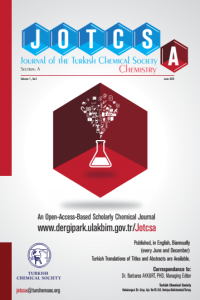Abstract
References
- 1. www.theplantlist.org, The Plant List, 115 (2013), The Plant List,116 (2018).
- 2. Karyagin, Flora of Azerbaijan. Academy of Sciences of Azerbaijan Institute of Botany.473-474 (1955).
- 3. Murray, R. D. H. Coumarins. Nat. Prod. Rep. 6, 477–505 (1995).
- 4. S.K.Serepanov, Vascular Plants of Russia and the Adjacent States.Cambridge University Press. (1995)
- 5.Askerov A.M., Higher plants of Azerbaijan. The concept of the flora of Azerbaijan.190 (2006).
- 6. KerimovS.Sh.,Kumarina Xanthogalum sachokianum. Chemistry of plant compounds.3, 371-372. (1986)
- 7.SerkerovSirajeddin., Terpenoidine phenol derivatives of plants of the Asteraceae and Apiaceae families. ANAS reports.311(2005),
- 8.Kuznetsova G.A., Natural coumarins, and furocoumarins. Science.248 (1967)
- 9. Galina A. Kuznetsova, Eleonora V. Markelova, Mark E. Perelson, et al. (−)-3′(R)-hydroxy-4′(S)-methoxy-3′4′-dihydroxanthyletin from the roots of Peucedanumarenarium.Phytochemistry.10,1805 (1978).
- 10. Prince M1, Campbell CT, Robertson TA, Wells AJ, Kleiner HE. Naturally occurring coumarins inhibit 7,12-dimethylbenz[a]anthracene DNA adduct formation in the mouse mammary gland. Carcinogenesis. 2006 Jun;27(6):1204-13. Epub 2005 Dec 29.
- 11. Fulton, James F.; Leyden, James; Papa, Christopher: Treatment of vitiligo with topical Xanthoxin and black-lite; Arch. Derm., 101, pp. 224-229 (1969).
- 12. Lacy A, O’Kennedy R (2004) Studies on coumarins and coumarin-related compounds to determine their therapeutic role in the treatment of cancer. Curr Pharm Des 10: 3797-3811.
Abstract
There are nearly 4500 kinds of plants in Azerbaijan flora. Among these plants, the Apiaceae Lindl family takes a special place. This family is represented in the world with 400 genders. Among the genders including this family Angelica L. Gender attracts attention for its specific features. There are 115 types of this gender in the world (plant list 2013, 115), (plant list 2018, 116) [1]. In Azerbaijan flora, Angelica L. gender is represented with 3 types: Angelica TatianaeBordz, A.sachokiana, and Angelica Purpurascens [2].
Angelica L. gender is a rare kind of Azerbaijan flora. A.Tatianae is a noticeable perennial plant. A.Tatianae is a very valuable medicinal plant with 1-1,5m height and an empty stem. It passes to the blooming phase in July, the flowers are white. The length of the petals is about 1-2mm. The columns are short cone-shaped. The column is much longer than under columns and they are folded. The length of the umbrellas consists of various, roughly 25-35 rays. The petals are white and are gathered in the umbrella flower group. The sizes of the edge and middle flowers are different. The grown seeds are wide oval-shaped, backbones are narrow, from sides are large winged, above is naked. The length of the seed is 10 mm; the width is 5-6mm and consists of ribs. The seed has a specific dark smell.
The leaf limb is wide triangle-shaped, consists of 3 parts, it is featherlike, the length is about 30 cm, initial slices of a leaf are wide egg-shaped and the length is 20-25cm. The deep featherlike cut sharply pointed part is 6-8cm. The edges are unequal sharp cogged; the veinlet is short-hairy especially at the bottom part. Inside the stem is empty. It has a bitter taste. Coumarins are widely spread in types of Apiaceae, especially in the genus Angelica L.
Root parts of Angelica Tatianae type which were gathered from the west part of the Azerbaijan Gadabay region were cut, dried and substance mixture (17g) was used by extraction with (120g) alcohol 3 times. Three substances were extracted from chromatography of extracts from the root system of AngeliciaTatianae. The structures of matter are determined chemically and spectrally. The thin layer chromatography method was used to determine the individuality of the substances derived from the root of the plant, which has been identified as substances isopimpinellin, coumarin, xanthotoxin.
Keywords
References
- 1. www.theplantlist.org, The Plant List, 115 (2013), The Plant List,116 (2018).
- 2. Karyagin, Flora of Azerbaijan. Academy of Sciences of Azerbaijan Institute of Botany.473-474 (1955).
- 3. Murray, R. D. H. Coumarins. Nat. Prod. Rep. 6, 477–505 (1995).
- 4. S.K.Serepanov, Vascular Plants of Russia and the Adjacent States.Cambridge University Press. (1995)
- 5.Askerov A.M., Higher plants of Azerbaijan. The concept of the flora of Azerbaijan.190 (2006).
- 6. KerimovS.Sh.,Kumarina Xanthogalum sachokianum. Chemistry of plant compounds.3, 371-372. (1986)
- 7.SerkerovSirajeddin., Terpenoidine phenol derivatives of plants of the Asteraceae and Apiaceae families. ANAS reports.311(2005),
- 8.Kuznetsova G.A., Natural coumarins, and furocoumarins. Science.248 (1967)
- 9. Galina A. Kuznetsova, Eleonora V. Markelova, Mark E. Perelson, et al. (−)-3′(R)-hydroxy-4′(S)-methoxy-3′4′-dihydroxanthyletin from the roots of Peucedanumarenarium.Phytochemistry.10,1805 (1978).
- 10. Prince M1, Campbell CT, Robertson TA, Wells AJ, Kleiner HE. Naturally occurring coumarins inhibit 7,12-dimethylbenz[a]anthracene DNA adduct formation in the mouse mammary gland. Carcinogenesis. 2006 Jun;27(6):1204-13. Epub 2005 Dec 29.
- 11. Fulton, James F.; Leyden, James; Papa, Christopher: Treatment of vitiligo with topical Xanthoxin and black-lite; Arch. Derm., 101, pp. 224-229 (1969).
- 12. Lacy A, O’Kennedy R (2004) Studies on coumarins and coumarin-related compounds to determine their therapeutic role in the treatment of cancer. Curr Pharm Des 10: 3797-3811.
Details
| Primary Language | English |
|---|---|
| Journal Section | Articles |
| Authors | |
| Publication Date | October 30, 2020 |
| Submission Date | January 1, 2020 |
| Acceptance Date | July 20, 2020 |
| Published in Issue | Year 2020 Volume: 7 Issue: 3 |



